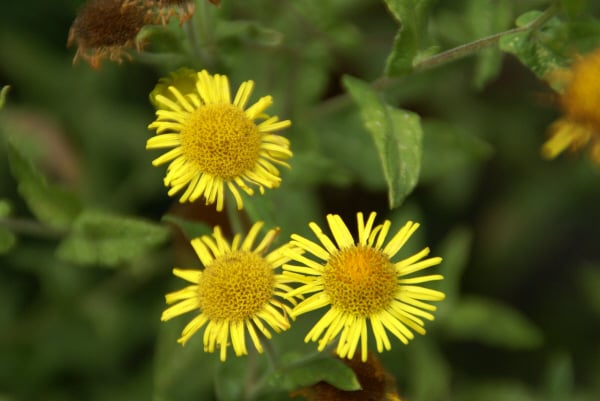Pulicaria dysenterica
common fleabane
A distinctly downy perennial 50-90cm tall, with creeping rhizomes and slightly heart-shaped, wavy-edged leaves that clasp the stems. Woolly flowering stems reach up to 1m in height with clusters of flat, yellow, daisy-like flower heads with short ray petals and are borne from midsummer to early autumn
Synonyms
Inula dysenterica
Buy this plant
Size
Ultimate height
0.5–1 metresTime to ultimate height
2–5 yearsUltimate spread
0.5–1 metresGrowing conditions
Moisture
Poorly–drained, Moist but well–drainedpH
Acid, Alkaline, NeutralColour & scent
| Stem | Flower | Foliage | Fruit | |
| Spring | Green | |||
|---|---|---|---|---|
| Summer | Yellow | Green | ||
| Autumn | Green | |||
| Winter |
Position
- Full sun
- Partial shade
Aspect
East–facing or South–facing or West–facing
Exposure
Sheltered Hardiness
H6Botanical details
- Family
- Asteraceae
- Native to GB / Ireland
- Yes
- Foliage
- Deciduous
- Habit
- Bushy
- Genus
Pulicaria are perennials with a preference for damp to marshy conditions. Growing to a height of around 50 to 90cm, they have hairy stems and lanceolate leaves with a wavy edge to them. The yellow flowers are short-lived appearing between August and September on long, thin stems. Flower heads are yellow and daisy-like, growing between 2 and 3 cm in width.
- Name status
Correct
How to grow
Cultivation
Grows naturally in wet marshy ground and enjoys sunny locations with reliably moist soil but can tolerate a range of soil conditions
Propagation
Propagate by division or propagate by seed
Suggested planting locations and garden types
- Wildlife gardens
- Wildflower meadow
Pruning
No pruning required
Pests
Generally pest-free
Diseases
Generally disease-free
Get involved
The Royal Horticultural Society is the UK’s leading gardening charity. We aim to enrich everyone’s life through plants, and make the UK a greener and more beautiful place.